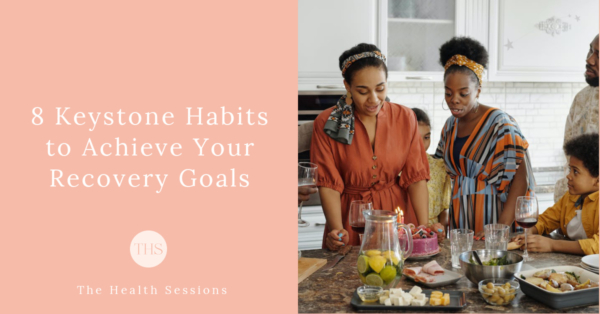12 Timeless Tips for a Healthy Lifestyle

This blog post contains some affiliate links to resources you may find useful, at no extra costs to you. All opinions are my own.
Ok, so you’re all fired up to work on your health and happiness. Maybe you’ll never get fully better again, but that doesn’t mean you can’t set meaningful recovery goals. It can still feel incredibly rewarding and freeing to being able to look after yourself again. Maybe you’d love to increase your mobility and get out of the house more often. Or perhaps you want to pick up a hobby again, go back to your job or make your dreams come true despite your health problems.
The question is, how do you start to achieve your recovery goals?
Research shows us that consistently taking small steps towards your goals works better than making drastic lifestyle changes that you can’t keep up with when you get busy, tired and overwhelmed. That’s why it’s so helpful to build healthy habits that are doable for you.
But with an overwhelming amount of health advice out there, which healthy habits are best to focus on?
Well, that depends on your specific goal – and your unique health and home situation. And the last thing you want is to overwhelm yourself, resulting in you quitting your plans in a few weeks time, so start small with one doable habit.
A good question to help you determine which healthy habits you should build first is:
Which small improvement would have the biggest positive impact on your overall wellbeing and quality of life?
Maybe being able to walk again would literally make your world a little bigger. Maybe having enough mental clarity and focus to return to school or work (even ‘just’ remote and part-time) would really improve your mood and sense of independence. Or perhaps slowly crowding out unhealthy foods could ease your painful gut problems and boost your energy levels.
Another helpful way to not get overwhelmed by all the wellness practices you could be building is by choosing keystone habits. According to Charles Duhigg, author of ‘The Power of Habits’, keystone habits are “small changes or habits that people introduce into their routines that unintentionally affect other aspects of their lives.” Instead of just improving one aspect of your wellbeing (like training your biceps for arm strength), a keystone habit enhances your health and happiness in several ways (like taking a morning walk exposes you to natural daylight, fresh air, sunshine and movement all in one).
Again, what turns out to be a keystone habit for you, depends on your recovery goal and personal situation. And this is by no means a conclusive list – maybe something more uncommon like singing will be the daily practice that supports your breathing, stress levels and mood.
But I can promise you that the 8 keystone habits below will bring you benefits and improvements in multiple areas of your life!

Your momma was right: eating your vegetables really is good for you. Getting your greens in is not only an simple way to up your nutrient intake, also to crowd out unhealthy foods without having to stick to a strict diet. After all, if your stomach is filled with cauliflower steaks, baked sweet potatoes or eggplant parmigiana, there’s a lot less room for pizza, ice cream and potato chips. Plus, did you know that consuming plenty of vegetables is linked to feeling happier? That’s what makes eating veggies such a good keystone habit.
Now you know about the power of plants, how you can add more vegetables to your meals? Most of us have gotten dinner covered, but it can be a lot to eat 2 to 3 cups of vegetables (200 to 250 grams a day) in one sitting. So it’s helpful to more eat veggies throughout the day. You could have a green smoothie bowl or eggs with spinach for breakfast, add slices of tomato to your regular cheese sandwich and snack on carrot sticks with dips or even beet berry muffins!.
Get inspired by these 24 exciting ways to eat vegetables with every meal.
Even in our sedentary society, being able to move around on foot has a huge impact on your quality of life. Having the mobility to walk around the supermarket for groceries, shop clothes or presents in the high street, use public transport or wander around a museum or the park makes your daily functioning so much easier – and fun!
Walking is the most natural form of movement that literally expands your world. Not only does it boost your health and happiness in big ways, walking is accessible for various fitness levels, no fancy equipment necessary. And you can get your movement, fresh air and sunshine in while ticking off things from your to-do list, like running errands or walking the kids to school.
But when you suffer from health problems that make it difficult to get off the couch, let alone head out the door, how can you start to increase your walking fitness?
First of all, for one week, track how many steps you’re currently taking by using an app or Fitbit. You could also simply note how many minutes you’re able to walk outside. Once you have a realistic picture of your average activity level, see if you can increase the amount of steps you take by 250 to 500, or lengthen your walks by 1 to 5 minutes. Stick to this new fitness level until you can walk that distance or duration comfortably, before you add another 250 steps or one minute to your walking routine.
It’s perfectly ok to plan a break halfway into your walk, whether that’s on a bench in the park or treating yourself to a matcha latte in a cozy coffee shop. You could also break your daily step goal into 2 or 3 shorter walks throughout the day if that works better for you. If you’re housebound, start by walking around the house for the duration of your favorite song, or simply get up during commercial breaks when watching TV.
Make your walks more fun by listening to audiobooks, looking for birds, butterflies and flowers, strolling a farmers market or taking photos of the amazing architecture, graffiti or nature around you. And you get bonus points for taking a ‘Morning Mile’, with all the added benefits of catching the early morning light outside that fine-tunes your body clock.
Check out the step-by-step instructions in ‘How to Work Your Way Up to Walking 10,000 Steps a Day.’
It’s one of the most overlooked aspects of living with a chronic illness: how diseases, medications and insomnia affect your brain functioning.
A common side effect of many illnesses is brain fog – the unofficial term for mentally feeling like you’re walking through thick mist, unable to think clearly or stay focused. Cognitive problems like mental fatigue, poor memory and a short attention span can disrupt your daily life in more ways than healthy people may realize. When you can’t focus well enough to read emails and long-form texts, do administrative tasks or have conversations, it’s hard to study, work and socialize. You understand why improving your attention span can be a keystone habit to achieve several recovery goals.
Thankfully, there are things you can do to optimize your brain functioning, like staying hydrated, practicing deep belly breathing and preventing sensory overload. What’s more, you can train your mental muscles to gradually improve your attention span.
Start by setting the scene for optimal concentration by limiting distractions (like clutter, notification pings and other interruptions) and scheduling tasks that require full focus during times when you’re most likely to feel mentally alert.
Next, build mental stamina by practicing mindfulness and meditation (also known as weightlifting for the mind), doing a mental workout like crossword puzzles and getting back into reading long-form texts. It also helps to lighten your cognitive workload by taming your to-do list and writing important things down.
Finally, use your mental energy wisely by only doing one thing at a time and alternating between different types of tasks that tap into different parts of your brain.
Learn more spoonie-proof strategies to improve your attention span.

Being outdoors – even in the city – benefits your physical and mental health in many ways, through a healthy dose of fresh air, vitamin-D producing sunshine and natural daylight. What’s more, spending time in natural surroundings reduces your stress levels and blood pressure, improves your immunity and boosts your mood, memory and attention span.
But getting outside is not always easy when you’re sick, especially when you have limited energy and mobility. It can help to see your outdoor time as nature therapy, that will help manage your symptoms or even support your recovery. Also, movement is not a requirement. You can simply drink your coffee in the garden or sit on a picnic blanket in the park for your daily nature fix. Use aids like a wheelchair, scooter or e-bike to make it easier to head outdoors or to get around.
If you’re stuck at home a lot, you can even bring the outdoors indoors by adorning your home with plants, growing fragrant herbs in your window box, putting up large photographs of your favorite landscapes and decorating your home with natural elements like shells, flowers and pine cones.
Here’s how you can get in 120 minutes of outdoor time each week, even if you’re chronically ill.
We all crave some form of connection, even if you’re introverted, neurodivergent or used to being home alone with chronic illness. Having strong relationships supports your mental health, strengthens your immune system and helps you recover from illness faster. Feeling connected to the people around you is even one of the keystone habits why people in so-called Blue Zones live such long and healthy lives.
But having health problems can change your relationships. Your family and friends may not always understand what you’re going through, and that hurts. It can also be challenging to socialize when you’re in pain every day, especially if you’re housebound. Or maybe you struggle with having to depend on others for help, which changes the dynamics between you and your loved ones.
Fortunately, you can still stay connected to the people in your life when you’re sick. Find ways to keep in touch, no matter if you can manage sweet text messages, FaceTiming or a short meet-ups at home. Stay interested in your friends’ and family’s lives too, even if their work problems or dating stories feel so frivolous compared to the life-changing situation you’re going through. Come up with new ways to have a good time together, whether that’s playing a board game on your bed or making your own pizzas at home.
When you’re struggling with pain, worries or other problems, be clear about what you need. Getting well-meant advice when you were looking for a comforting hug can unintentionally cause friction. At the same time, we often shrug off comments like “let me know if I can help”, while you could really use a helping hand with a specific task.
Finally, remember that every relationship goes through different phases, for all kinds of reasons, not just chronic illness. Things may not be the same as before you became ill, but that doesn’t mean that change is always bad. It could also open up new doors to deeper connections, new people in your life and a better understanding of yourself.
Take a look how you can form new friendships, be a good friend despite your illness and communicate your limitations clearly to your loved ones.

Sounds dull and childish, right? But waking up and going to bed at roughly the same times every day really helps you get a good night’s sleep, which in turn supports every function in your body.
One reason why your body and brain love a consistent sleeping schedule is because that makes it easier to sync up your internal clock to the daily 24-hour pattern called the circadian rhythm. Disrupting your body clock by staying up late every weekend, doing shift work or traveling through different timezones can lead to grogginess, weight gain, heart disease and cognitive decline.
Giving yourself a bedtime helps you to get enough sleep, and consequently boosts your performance, improves your mood and focus, and strengthens your ability to make healthier decisions during the day. Plus, when you know what time you’d like to go to bed, you can start unwinding an hour beforehand, to signal to your brain and body it’s time to start preparing for sleep.
To build this keystone habit, all you have to do is determine what time you have to get up in the morning and count a little more than 8 hours backwards. If you’re used to going to bed at varying times, you might not feel sleepy when your new bedtime rolls around. That’s why it’s helpful to create a relaxing nighttime routine to let go of tension from your body, calm your mind and set the scene for sleeping.
Take inspiration from these 9 relaxing routines to wind down at night, and see what you could do if ‘painsomnia‘ stops you from getting restful sleep.
I’m not a proponent of a specific diet or strict food patterns in general, but the research is clear that refined sugar wrecks havoc on our health. Eating too much sugar leads to weight gain, high blood pressure and chronic inflammation, which are all risk factors for heart disease and strokes. And most of us know that a diet high in sugar is linked to diabetes type 2 and obesity.
Perhaps more surprisingly, a high sugar consumption is also linked to depression and anxiety, probably as a result of chronic inflammation and insulin resistance. Studies also show that people with high blood sugar levels have a faster rate of cognitive decline than those with normal blood sugar — even if they are not technically diabetic.
So reducing your sugar intake is a keystone habit that boosts your health and happiness in multiple ways. One of the most effective ways to consume less sugar is by cutting down on soda drinks and fruit juices. Having just one sugary drink a day can already increase your chances of developing diabetes by 26%! So swap your soda for water (plain, infused or sparkling) vegetable juice, (unsweetened) nut milk or homemade iced tea.
It also helps to learn which everyday products secretly contain tons of sugar, like many granolas, fruit yoghurts and even soups and condiments. Experiment with healthier ways to satisfy your sweet tooth. You could browse Pinterest or food blogs for healthier takes on cakes. ice cream and desserts.
But most important, identify which underlying feelings or social situations trigger your cravings for sweets. Once you know what makes you reach for the cookie jar, you can make a plan to resist common temptations.
See how you can curb your cravings too in 6 simple steps.

According to science, practicing gratitude by writing down 3 positive things that happened that day is the most effective way to boost your overall happiness. Gratitude journaling trains your brain to look out for the good things in life, and that habit will boosts your mood and make you feel more optimistic about the future. Feeling thankful also supports your physical health, by reducing stress, improving sleep and sticking to healthier habits.
The easiest way to start gratitude journaling is by getting a beautiful notebook and just jotting down 3 or more things that went well that day. You could also use journal prompts like ”Thank you for…” and “What I’ve been loving lately is…” to reflect back. It’s a simple daily practice, but studies show time and time again, that feeling grateful can improve your life in many different ways.
Find out more ways you can practice genuine gratitude, even if you don’t feel like it.
Reaching your recovery goals take time, and it often goes with ups and downs. But the best way to build a healthier lifestyle without getting overwhelmed or burned-out is by choosing one keystone habit that you can stick to even when life’s challenging.
Which keystone habit will you be focusing on to achieve your recovery goals?
For a step-by-step guide on how you can start to rebuild your health after illness, check out my ebook ‘How to Create Your Own Action Plan for Recovery’.